The Impact of Minimally Invasive Surgical Modality and Task Complexity on Cognitive Workload: An fNIRS Study
Abstract
:1. Introduction
- For complex surgical tasks, mental demand would be different between laparoscopic and robotic surgery, and this difference can be determined by identifying cognitive workload using neurophysiological measures from the prefrontal cortex.
- Regardless of surgical modality (laparoscopic or robotic), increasing task complexity (e.g., knot tying vs. PP) will result in higher task load and thus elevated cognitive workload.
2. Materials and Methods
2.1. Participants
2.2. Experimental Protocol
2.2.1. Laparoscopic Surgery Training Protocol
2.2.2. Robotic Surgery Training Protocol
2.3. fNIRS Recording and Preprocessing
2.4. Statistical Analysis
3. Results
3.1. Results for Completion Time
3.2. Results for Mean ΔHbO
4. Discussion
4.1. Modality Effect
4.2. Task Complexity Effect
4.3. Simulation vs. Real-Life Systems
5. Conclusions
6. Limitations
Author Contributions
Funding
Institutional Review Board Statement
Informed Consent Statement
Data Availability Statement
Acknowledgments
Conflicts of Interest
Abbreviations
| fNIRS | Functional Near-Infrared Spectroscopy |
| FLS | Fundamentals of Laparoscopic Surgery |
| FRS | Fundamentals of Robotic Surgery |
| Hb | Hemoglobin |
| HbO2 | Oxygenated hemoglobin |
| HbR | Deoxygenated hemoglobin |
| PFC | Prefrontal Cortex |
| LAMPFC | Left Anterior Medial Prefrontal Cortex |
| LDLPFC | Left Dorsolateral Prefrontal Cortex |
| RAMPFC | Right Anterior Medial Prefrontal Cortex |
| RDLPFC | Right Dorsolateral Prefrontal Cortex |
| KT | Knot tying |
| PP | Pick and place |
| RNI | Relative neural involvement |
| RNE | Relative neural efficiency |
| ROI | Region of interest |
References
- Buia, A.; Stockhausen, F.; Hanisch, E. Laparoscopic surgery: A qualified systematic review. World J. Methodol. 2015, 5, 238–254. [Google Scholar] [CrossRef] [PubMed]
- De Marchi, D.; Mantica, G.; Tafuri, A.; Giusti, G.; Gaboardi, F. Robotic surgery in urology: A review from the beginning to the single-site. AME Med. J. 2021, 7. [Google Scholar] [CrossRef]
- Shugaba, A.; Lambert, J.E.; Bampouras, T.M.; Nuttall, H.E.; Gaffney, C.J.; Subar, D.A. Should All Minimal Access Surgery Be Robot-Assisted? A Systematic Review into the Musculoskeletal and Cognitive Demands of Laparoscopic and Robot-Assisted Laparoscopic Surgery. J. Gastrointest. Surg. 2022, 26, 1520–1530. [Google Scholar] [CrossRef]
- Gamal, A.; Moschovas, M.C.; Jaber, A.R.; Saikali, S.; Perera, R.; Headley, C.; Patel, E.; Rogers, T.; Roche, M.W.; Leveillee, R.J.; et al. Clinical applications of robotic surgery platforms: A comprehensive review. J. Robot. Surg. 2024, 18, 29. [Google Scholar] [CrossRef]
- Biswas, P.; Sikander, S.; Kulkarni, P. Recent advances in robot-assisted surgical systems. Biomed. Eng. Adv. 2023, 6, 100109. [Google Scholar] [CrossRef]
- Alkatout, I.; Mechler, U.; Mettler, L.; Pape, J.; Maass, N.; Biebl, M.; Gitas, G.; Laganà, A.S.; Freytag, D. The Development of Laparoscopy—A Historical Overview. Front. Surg. 2021, 8, 799442. [Google Scholar] [CrossRef] [PubMed]
- Herron, D.M.; Marohn, M. A consensus document on robotic surgery. Surg. Endosc. 2007, 22, 313–325. [Google Scholar] [CrossRef]
- Shah, A.A.; Bandari, J.; Pelzman, D.; Davies, B.J.; Jacobs, B.L. Diffusion and adoption of the surgical robot in urology. Transl. Androl. Urol. 2019, 10, 2151–2157. [Google Scholar] [CrossRef]
- Zendejas, B.; Brydges, R.; Hamstra, S.J.; Cook, D.A. State of the Evidence on Simulation-Based Training for Laparoscopic Surgery. Ann. Surg. 2013, 257, 586–593. [Google Scholar] [CrossRef]
- Agha, R.A.; Fowler, A.J. The Role and Validity of Surgical Simulation. Int. Surg. 2015, 100, 350–357. [Google Scholar] [CrossRef]
- Qian, K.; Bai, J.; Yang, X.; Pan, J.; Zhang, J. Essential techniques for laparoscopic surgery simulation. Comput. Animat. Virtual Worlds 2016, 28, e1724. [Google Scholar] [CrossRef]
- Fundamentals of Laparoscopic Surgery. Fundamentals of Laparoscopic Surgery. 2025. Available online: https://www.flsprogram.org/about-fls/ (accessed on 5 February 2025).
- Intuitive. da Vinci Training. 2025. Available online: https://www.intuitive.com/ (accessed on 5 February 2025).
- Hur, H.-C.; Arden, D.; Dodge, L.E.; Zheng, B.; Ricciotti, H.A. Fundamentals of Laparoscopic Surgery: A Surgical Skills Assessment Tool in Gynecology. JSLS J. Soc. Laparoendosc. Surg. 2011, 15, 21–26. [Google Scholar] [CrossRef]
- Mizota, T.; Dodge, V.G.; Stefanidis, D. Fundamentals of Robotic Surgery. In Fundamentals of General Surgery; Springer: Berlin/Heidelberg, Germany, 2018; pp. 215–225. [Google Scholar]
- Roy, R.N.; Moly, A.; Dehais, F.; Scannella, S. EEG and FNIRS Connectivity Features for Mental Workload Assessment. In Neuroergonomics; Academic Press: Cambridge, MA, USA, 2018; pp. 327–328. [Google Scholar]
- Izzetoglu, M.; Bunce, S.C.; Izzetoglu, K.; Onaral, B.; Pourrezaei, K. Functional brain imaging using near-infrared technology. IEEE Eng. Med. Biol. Mag. 2007, 26, 38–46. [Google Scholar] [CrossRef] [PubMed]
- Strangman, G.; Boas, D.A.; Sutton, J.P. Non-invasive neuroimaging using near-infrared light. Biol. Psychiatry 2002, 52, 679–693. [Google Scholar] [CrossRef]
- Watson, J.; Sargent, A.; Topoglu, Y.; Ye, H.; Zhong, W.; Suri, R.; Ayaz, H. Using fNIRS and EDA to Investigate the Effects of Messaging Related to a Dimensional Theory of Emotion. In Advances in Neuroergonomics and Cognitive Engineering; Springer: Berlin/Heidelberg, Germany, 2020; pp. 59–67. [Google Scholar]
- Richards, D.; Izzetoglu, K.; Armstrong, J. Using Functional near Infrared Spectroscopy to Assess Cognitive Performance of UAV Sensor Operators during Route Scanning. In Proceedings of the 11th International Joint Conference on Biomedical Engineering Systems and Technologies, Madeira, Portugal, 19–21 January 2018; pp. 286–293. [Google Scholar]
- Irani, F.; Platek, S.M.; Bunce, S.; Ruocco, A.C.; Chute, D. Functional Near Infrared Spectroscopy (fNIRS): An Emerging Neuroimaging Technology with Important Applications for the Study of Brain Disorders. Clin. Neuropsychol. 2007, 21, 9–37. [Google Scholar] [CrossRef] [PubMed]
- Wilson, G.F.; Russell, C.A. Operator Functional State Classification Using Multiple Psychophysiological Features in an Air Traffic Control Task. Human Factors: J. Hum. Factors Ergon. Soc. 2003, 45, 381–389. [Google Scholar] [CrossRef]
- Ayaz, H.; Shewokis, P.A.; Bunce, S.; Izzetoglu, K.; Willems, B.; Onaral, B. Optical brain monitoring for operator training and mental workload assessment. NeuroImage 2012, 59, 36–47. [Google Scholar] [CrossRef]
- Varandas, R.; Lima, R.; I Badia, S.B.; Silva, H.; Gamboa, H. Automatic Cognitive Fatigue Detection Using Wearable fNIRS and Machine Learning. Sensors 2022, 22, 4010. [Google Scholar] [CrossRef]
- Causse, M.; Chua, Z.; Peysakhovich, V.; Del Campo, N.; Matton, N. Mental workload and neural efficiency quantified in the prefrontal cortex using fNIRS. Sci. Rep. 2017, 7, 5222. [Google Scholar] [CrossRef]
- Wilson, C.R.E.; Gaffan, D.; Browning, P.G.; Baxter, M.G. Functional localization within the prefrontal cortex: Missing the forest for the trees? Trends Neurosci. 2010, 33, 533–540. [Google Scholar] [CrossRef]
- Aron, A.R.; Robbins, T.W.; Poldrack, R.A. Inhibition and the right inferior frontal cortex. Trends Cogn. Sci. 2004, 8, 170–177. [Google Scholar] [CrossRef] [PubMed]
- Miller, E.K.; Cohen, J.D. An Integrative Theory of Prefrontal Cortex Function. Annu. Rev. Neurosci. 2001, 24, 167–202. [Google Scholar] [CrossRef] [PubMed]
- Duncan, J. The multiple-demand (MD) system of the primate brain: Mental programs for intelligent behaviour. Trends Cogn. Sci. 2010, 14, 172–179. [Google Scholar] [CrossRef] [PubMed]
- Chen, Y.; Cao, Z.; Mao, M.; Sun, W.; Song, Q.; Mao, D. Increased cortical activation and enhanced functional connectivity in the prefrontal cortex ensure dynamic postural balance during dual-task obstacle negotiation in the older adults: A fNIRS study. Brain Cogn. 2022, 163, 105904. [Google Scholar] [CrossRef]
- Koshino, H.; Minamoto, T.; Ikeda, T.; Osaka, M.; Otsuka, Y.; Osaka, N. Anterior Medial Prefrontal Cortex Exhibits Activation during Task Preparation but Deactivation during Task Execution. PLoS ONE 2011, 6, e22909. [Google Scholar] [CrossRef]
- Koechlin, E.; Basso, G.; Pietrini, P.; Panzer, S.; Grafman, J. The role of the anterior prefrontal cortex in human cognition. Nature 1999, 399, 148–151. [Google Scholar] [CrossRef]
- Aksoy, M.E.; Izzetoglu, K.; Agrali, A.; Kitapcioglu, D.; Gungor, M.; Simsek, A. Effect of Robotic Surgery Simulators in Training Assessed by Functional Near-Infrared Spectroscopy (fNIRs), in Augmented Cognition. In Human Cognition and Behavior; Springer: Cham, Switzerland, 2020; pp. 271–278. [Google Scholar]
- Izzetoglu, K.; Ayaz, H.; Merzagora, A.; Izzetoglu, M.; Shewokis, P.A.; Bunce, S.C.; Pourrezaei, K.; Rosen, A.; Onaral, B. The Evolution of Field Deployable fNIR spectroscopy from Bench to Clinical Settings. J. Innov. Opt. Health Sci. 2011, 04, 239–250. [Google Scholar] [CrossRef]
- Rashidi Fathabadi, F.; Grantner, J.L.; A Shebrain, S.; Abdel-Qader, I. Autonomous sequential surgical skills assessment for the peg transfer task in a laparoscopic box-trainer system with three cameras. Robotica 2023, 41, 1837–1855. [Google Scholar] [CrossRef]
- Ekçi, B. A simple technique for knot tying in single incision laparoscopic surgery (SILS). Clinics 2010, 65, 1055–1057. [Google Scholar] [CrossRef]
- Bogar, P.Z.; Virag, M.; Bene, M.; Hardi, P.; Matuz, A.; Schlegl, A.T.; Toth, L.; Molnar, F.; Nagy, B.; Rendeki, S. Validation of a novel, low-fidelity virtual reality simulator and an artificial intelligence assessment approach for peg transfer laparoscopic training. Sci. Rep. 2024, 14, 16702. [Google Scholar] [CrossRef]
- Loukas, C. Surgical Simulation Training Systems: Box Trainers, Virtual Reality and Augmented Reality Simulators. Int. J. Adv. Robot. Autom. 2016, 1, 1–9. [Google Scholar] [CrossRef]
- Izzetoglu, M.; Izzetoglu, K.; Bunce, S.; Ayaz, H.; Devaraj, A.; Onaral, B.; Pourrezaei, K. Functional near-infrared neuroimaging. IEEE Trans. Neural Syst. Rehabil. Eng. Eng. Med. Biol. Soc. 2005, 13, 153–159. [Google Scholar] [CrossRef]
- Brigadoi, S.; Ceccherini, L.; Cutini, S.; Scarpa, F.; Scatturin, P.; Selb, J.; Gagnon, L.; Boas, D.A.; Cooper, R.J. Motion artifacts in functional near-infrared spectroscopy: A comparison of motion correction techniques applied to real cognitive data. NeuroImage 2014, 85, 181–191. [Google Scholar] [CrossRef] [PubMed]
- Reddy, P.; Izzetoglu, M.; Shewokis, P.A.; Sangobowale, M.; Diaz-Arrastia, R.; Izzetoglu, K. Evaluation of fNIRS signal components elicited by cognitive and hypercapnic stimuli. Sci. Rep. 2021, 11, 23457. [Google Scholar] [CrossRef]
- Dans, P.W.; Foglia, S.D.; Nelson, A.J. Data Processing in Functional Near-Infrared Spectroscopy (fNIRS) Motor Control Research. Brain Sci. 2021, 11, 606. [Google Scholar] [CrossRef]
- Tak, S.; Ye, J.C. Statistical analysis of fNIRS data: A comprehensive review. NeuroImage 2014, 85, 72–91. [Google Scholar] [CrossRef]
- Cohen, J. Statistical Power Analysis for the Behavioral Sciences; Routledge: London, UK, 2013. [Google Scholar]
- Seabold, S.; Perktold, J. Statsmodels: Econometric and Statistical Modeling with Python. In Proceedings of the 9th Python in Science Conference 2010, Austin, TX, USA, 28 June–3 July 2010. [Google Scholar]
- Vallat, R. Pingouin: Statistics in Python. J. Open Source Softw. 2018, 3, 1026. [Google Scholar] [CrossRef]
- Virtanen, P.; Gommers, R.; Oliphant, T.E.; Haberland, M.; Reddy, T.; Cournapeau, D.; Burovski, E.; Peterson, P.; Weckesser, W.; Bright, J.; et al. SciPy 1.0: Fundamental algorithms for scientific computing in Python. Nat. Methods 2020, 17, 261–272. [Google Scholar] [CrossRef] [PubMed]
- Hunter, J.D. Matplotlib: A 2D Graphics Environment. Comput. Sci. Eng. 2007, 9, 90–95. [Google Scholar] [CrossRef]
- Su, W.-C.; Dashtestani, H.; Miguel, H.O.; Condy, E.; Buckley, A.; Park, S.; Perreault, J.B.; Nguyen, T.; Zeytinoglu, S.; Millerhagen, J.; et al. Simultaneous multimodal fNIRS-EEG recordings reveal new insights in neural activity during motor execution, observation, and imagery. Sci. Rep. 2023, 13, 5151. [Google Scholar] [CrossRef]
- Roy, R.N.; Charbonnier, S.; Campagne, A.; Bonnet, S. Efficient mental workload estimation using task-independent EEG features. J. Neural Eng. 2016, 13, 026019. [Google Scholar] [CrossRef] [PubMed]
- Singh, H.; Modi, H.N.; Ranjan, S.; Dilley, J.W.R.; Airantzis, D.; Yang, G.-Z.; Darzi, A.; Leff, D.R. Robotic Surgery Improves Technical Performance and Enhances Prefrontal Activation During High Temporal Demand. Ann. Biomed. Eng. 2018, 46, 1621–1636. [Google Scholar] [CrossRef] [PubMed]
- Lee, G.I.; Lee, M.R.; Clanton, T.; Sutton, E.; Park, A.E.; Marohn, M.R. Comparative assessment of physical and cognitive ergonomics associated with robotic and traditional laparoscopic surgeries. Surg. Endosc. 2013, 28, 456–465. [Google Scholar] [CrossRef] [PubMed]
- Berguer, R.; Smith, W. An Ergonomic Comparison of Robotic and Laparoscopic Technique: The Influence of Surgeon Experience and Task Complexity. J. Surg. Res. 2006, 134, 87–92. [Google Scholar] [CrossRef]

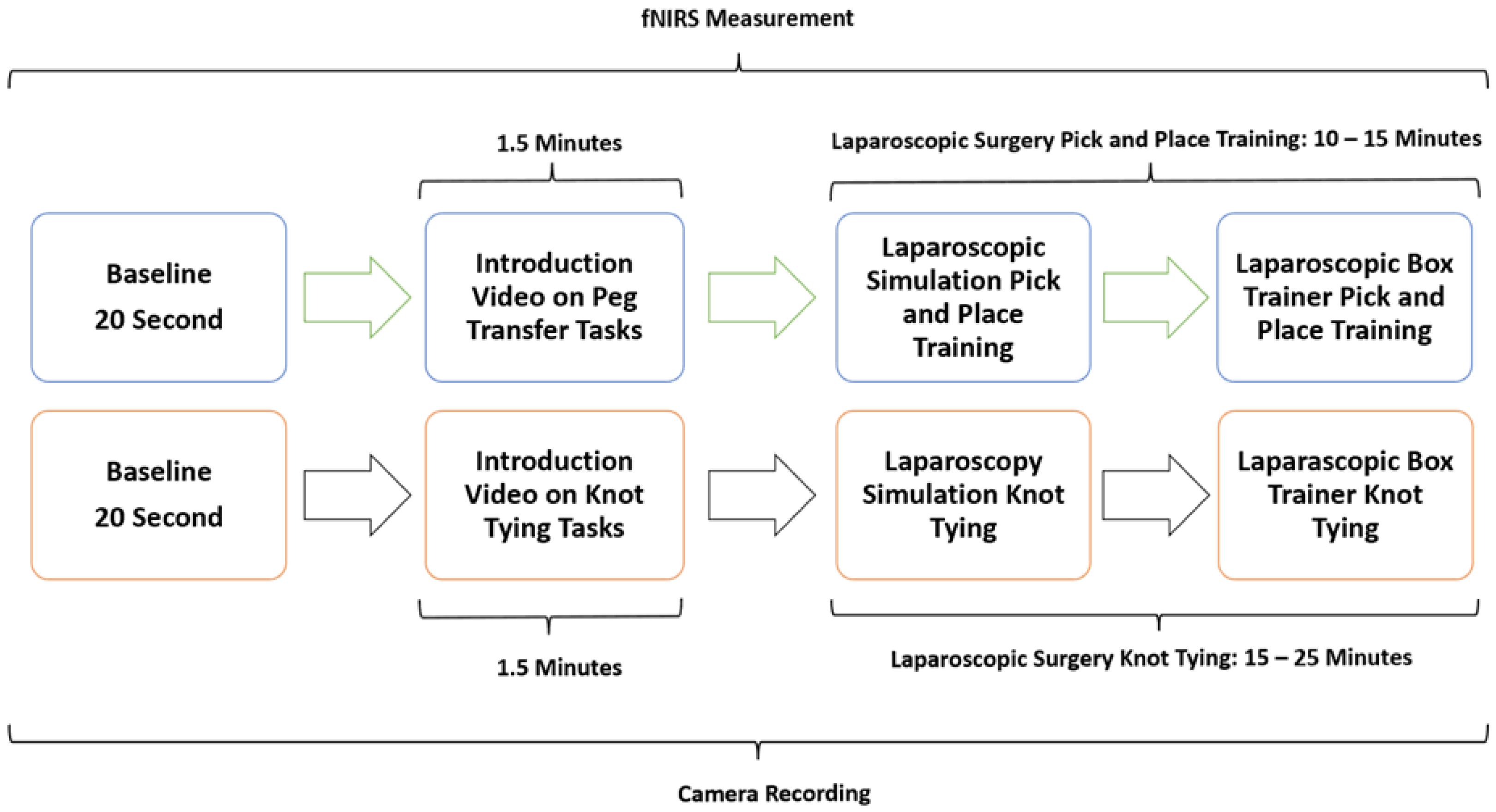
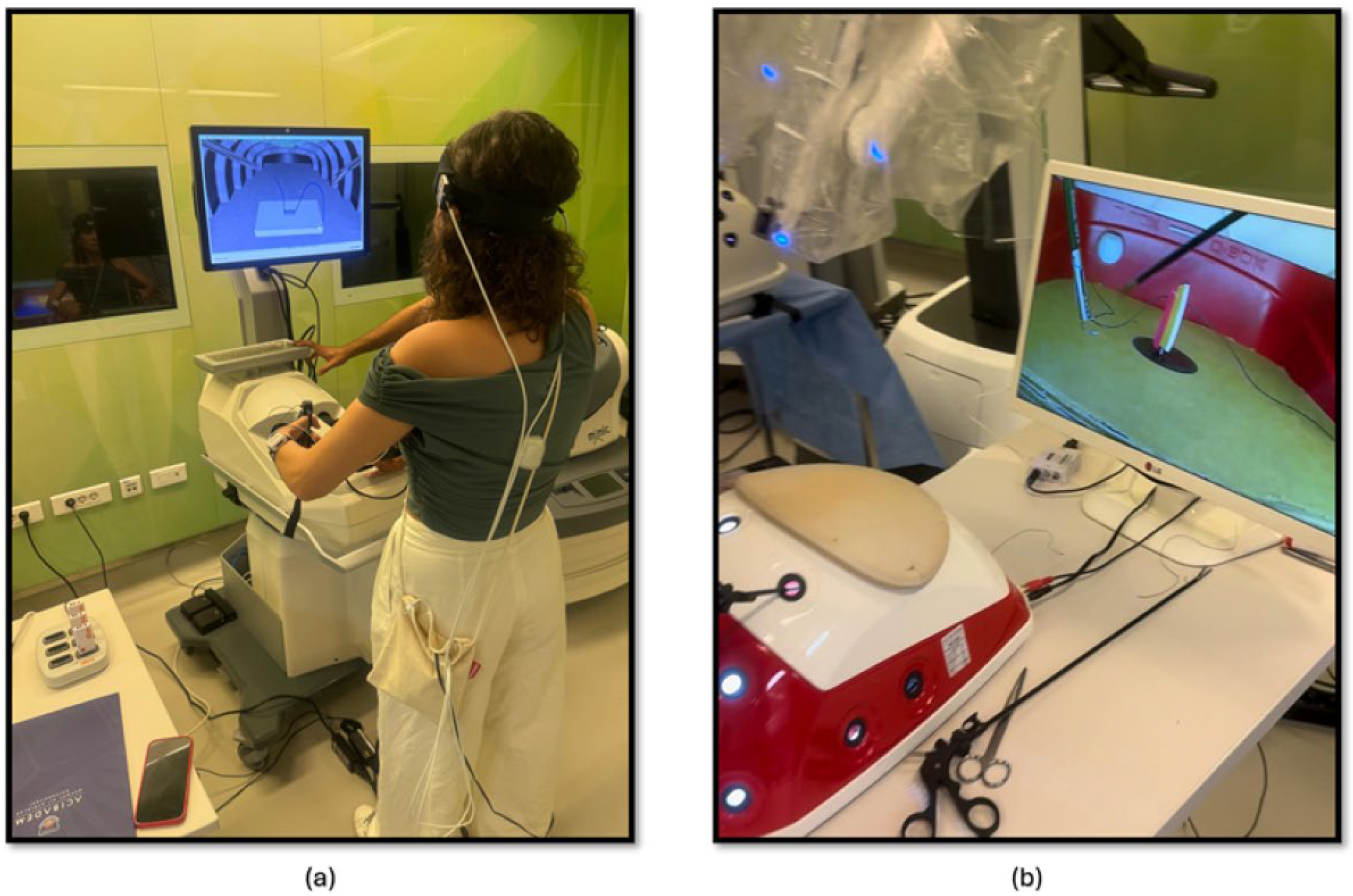
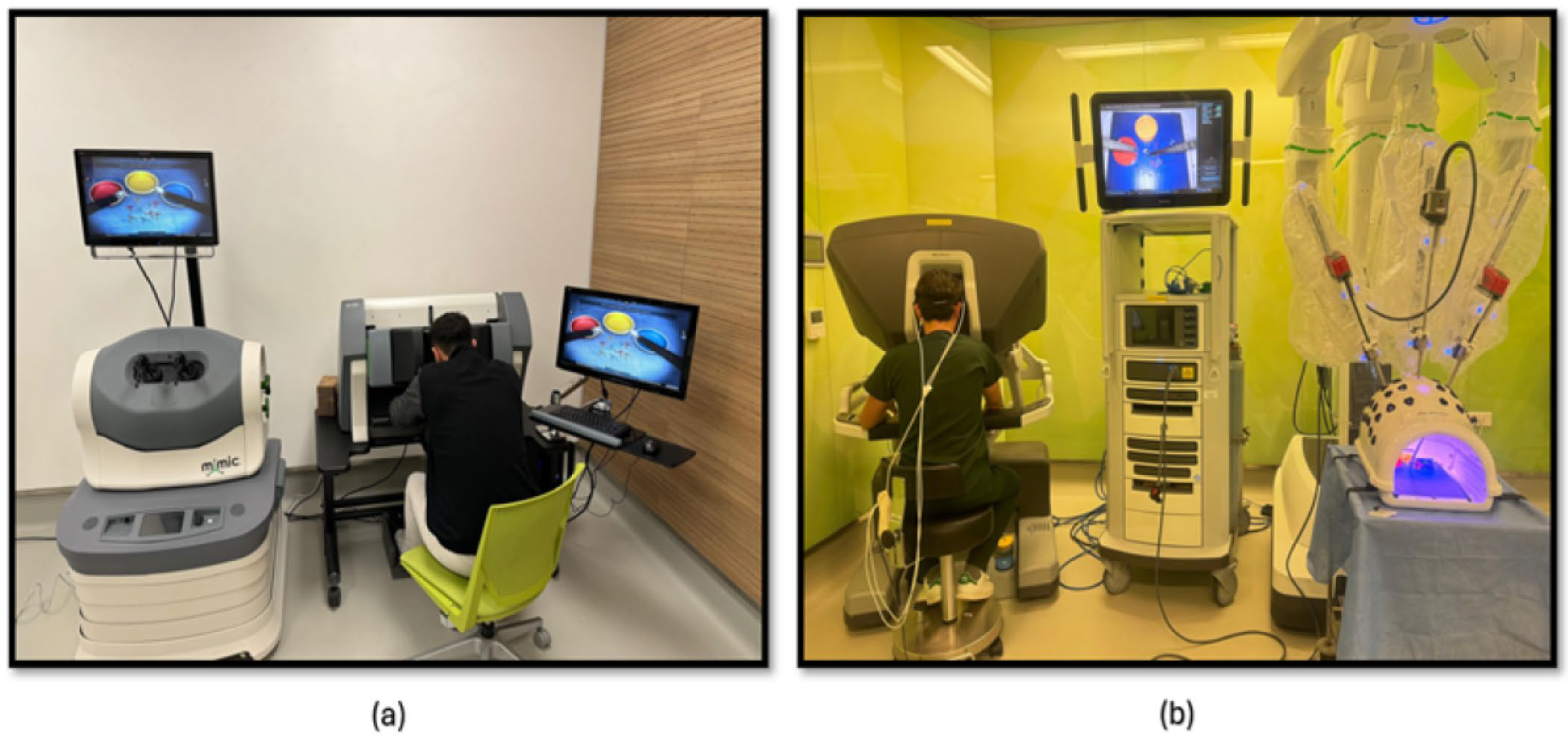
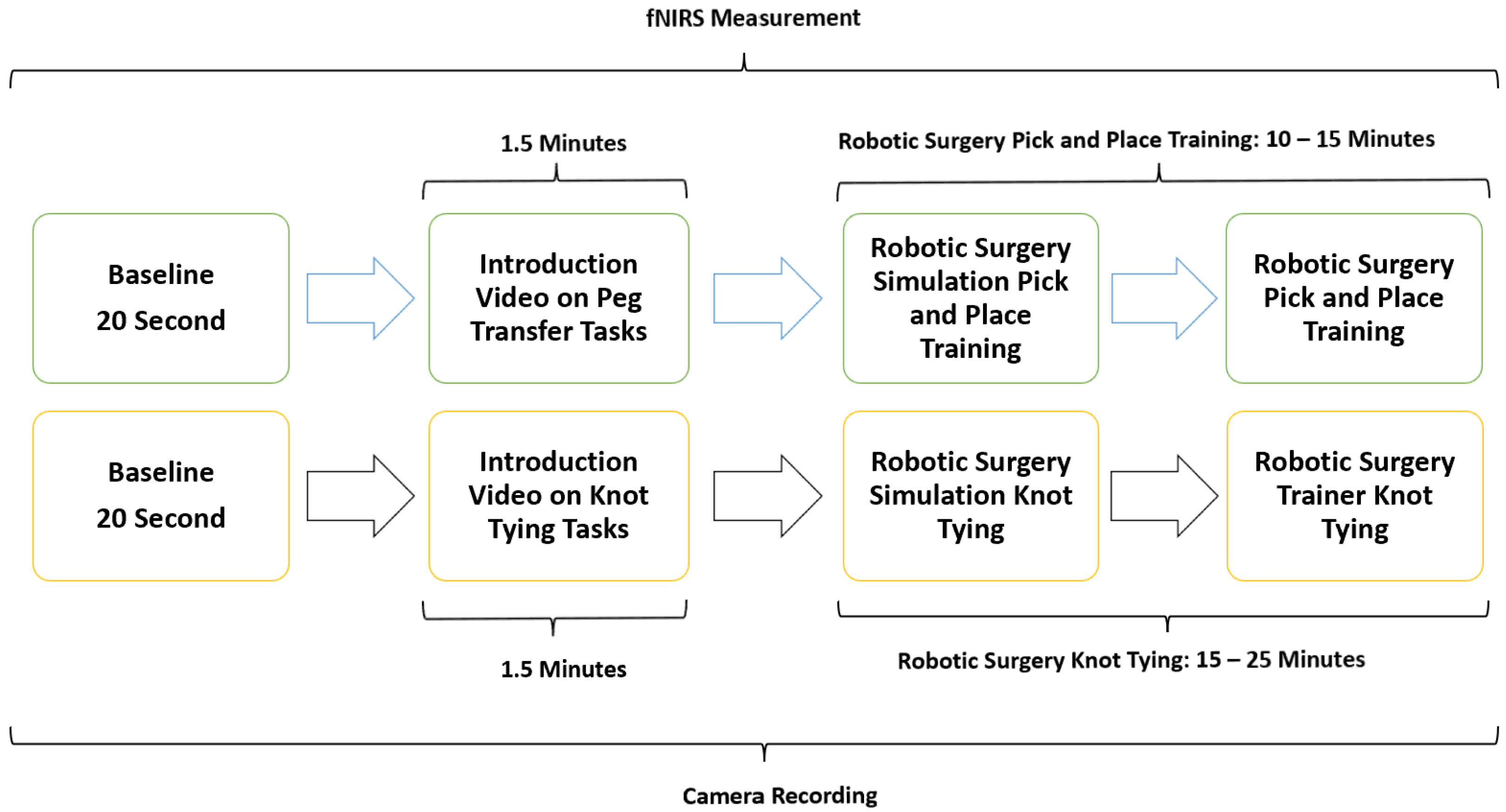
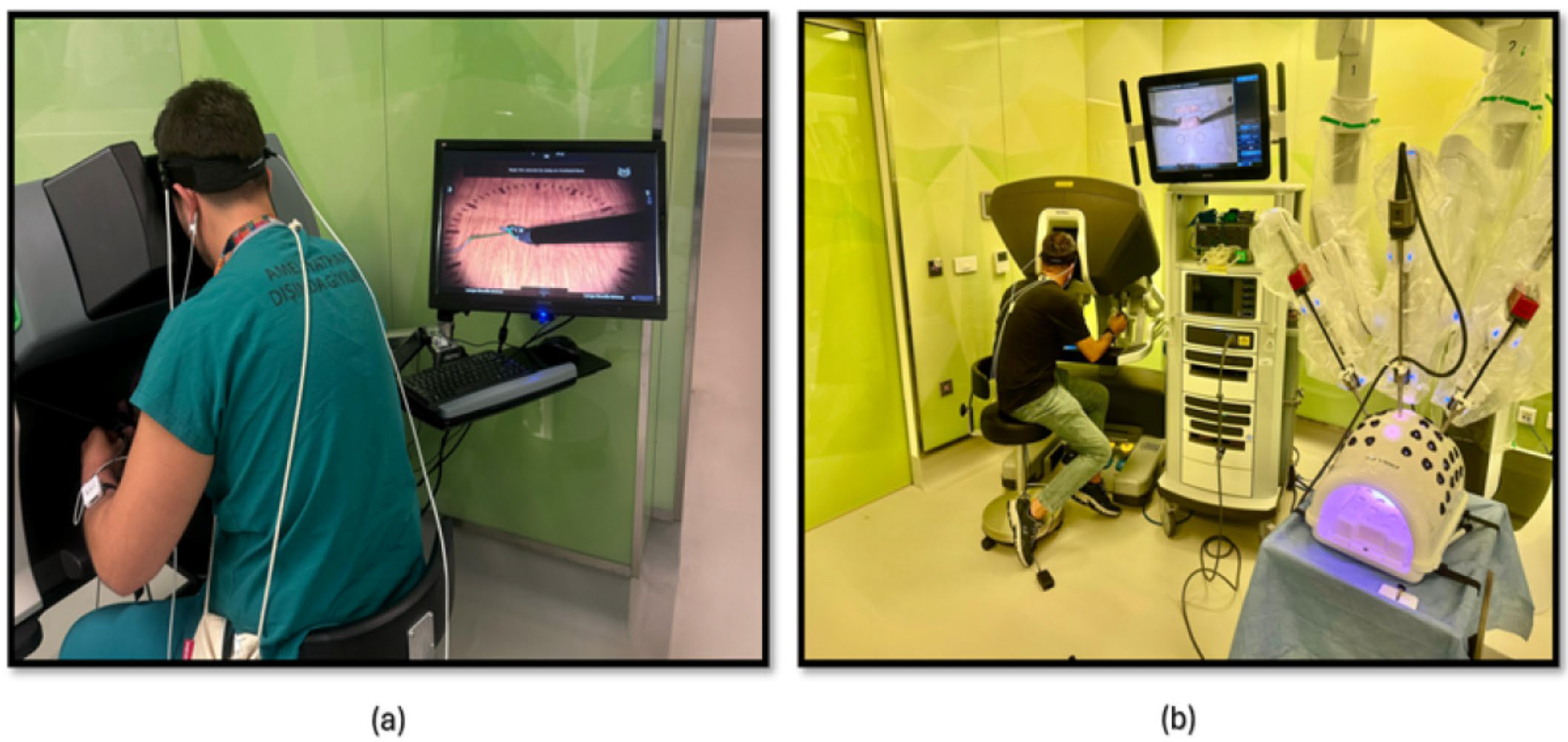
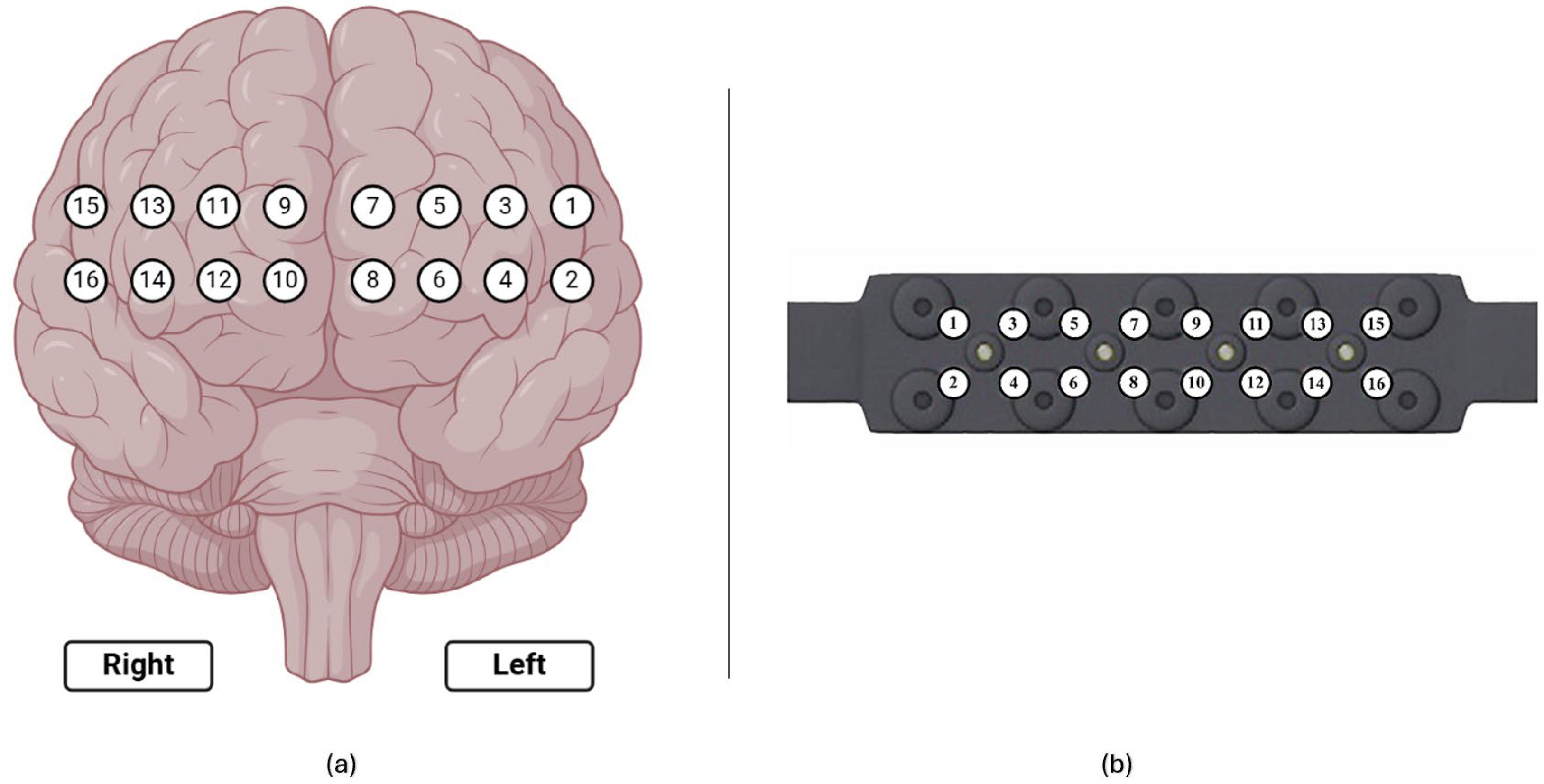

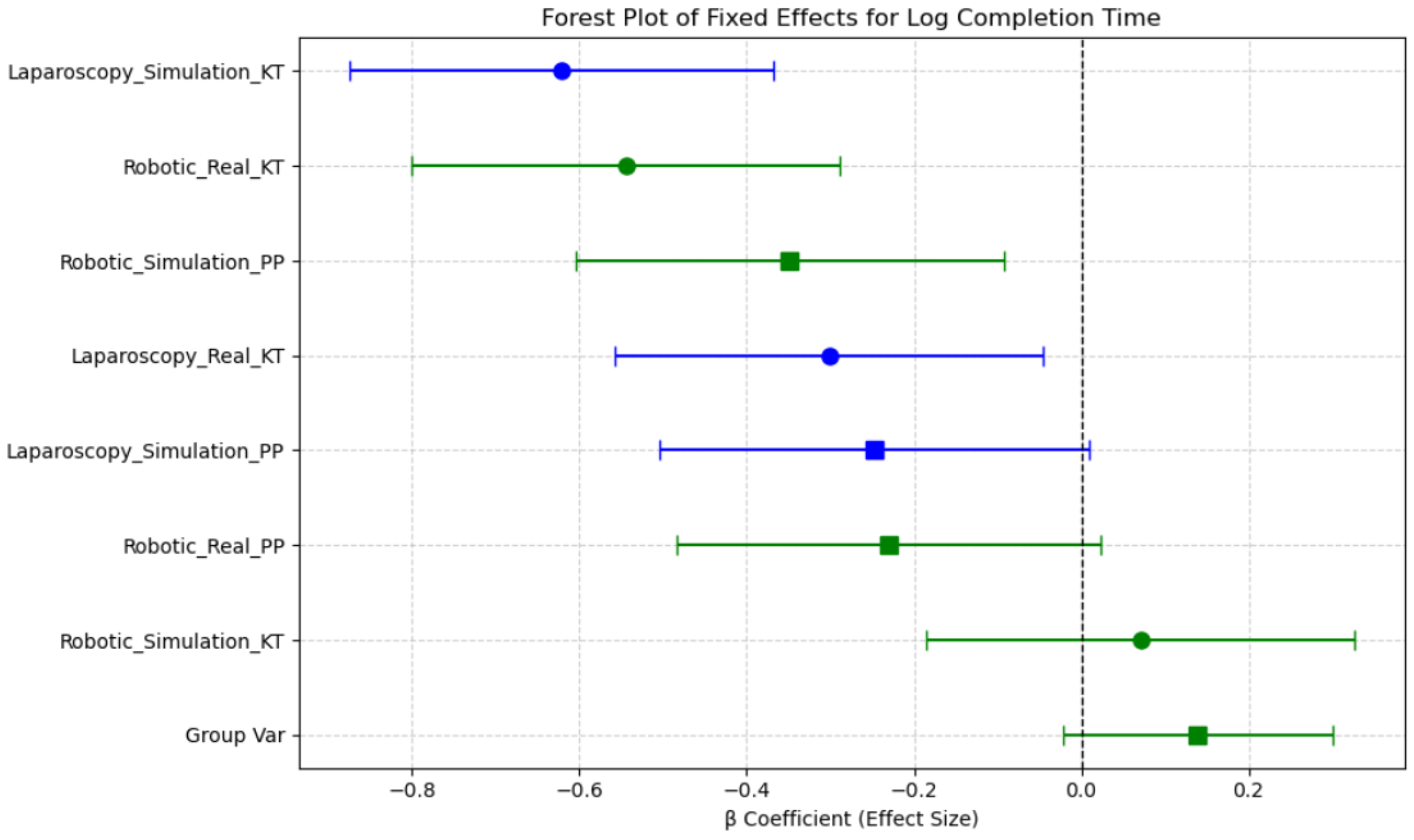

| Subject | Age | Gender | Handedness | Specialization (in Surgery) | Experience Level (Year) |
|---|---|---|---|---|---|
| Resident (R) | |||||
| R1 | 30 | Male | Right | General | 3.5 |
| R2 | 28 | Male | Right | General | 1.0 |
| R3 | 29 | Female | Right | General | 3.0 |
| R4 | 28 | Female | Right | General | 2.0 |
| R5 | 27 | Male | Right | General | 1.5 |
| R6 | 33 | Male | Right | General | 2.0 |
| R7 | 28 | Female | Right | Gynecology | 0.5 |
| R8 | 28 | Female | Right | Gynecology | 0.5 |
| R9 | 29 | Female | Right | Gynecology | 1 |
| R10 | 26 | Female | Right | Gynecology | 0 |
| R11 | 29 | Male | Right | Gynecology | 0 |
| R12 | 35 | Male | Right | Gynecology | 0 |
| R13 | 28 | Female | Right | Gynecology | 0.5 |
| R14 | 33 | Female | Right | Gynecology | 0 |
| R15 | 28 | Female | Right | Gynecology | 0 |
| R16 | 26 | Male | Right | Gynecology | 0 |
| R17 | 26 | Male | Right | Gynecology | 0.5 |
| R18 | 28 | Female | Right | Gynecology | 2 |
| R19 | 34 | Male | Right | Gynecology | 1 |
| R20 | 31 | Male | Right | Gynecology | 2 |
| R21 | 31 | Male | Right | Gynecology | 3 |
| Expert (E) | |||||
| E1 | 35 | Male | Left | Gynecology | 3.0 |
| E2 | 34 | Female | Right | Gynecology | 3.5 |
| E3 | 34 | Female | Right | Gynecology | 4 |
| E4 | 32 | Male | Right | Gynecology | 4 |
| E5 | 33 | Male | Right | Gynecology | 4 |
| Dependent Variable | Log10 Transform of Completion Time logLik | HbO | ||
|---|---|---|---|---|
| Main Effect | Session | Full Factorial * | Session | Full Factorial * |
| AIC | 279.589 | 307.826 | 842.519 | 882.962 |
| BIC | 312.216 | 327.402 | 875.093 | 902.507 |
| Log Likelihood | 129.794 | −147.913 | −411.259 | −435.481 |
| Deviance | 259.589 | 295.826 | 822.519 | 870.962 |
| R2 Conditional | 0.305 | 0.094 | 0.491 | 0.351 |
| R2 marginal | 1.000 | 1.000 | 0.564 | 0.416 |
| ICC | 0.120 | 0.074 | 0.144 | 0.099 |
| Contrast | Completion Time | |||||||
|---|---|---|---|---|---|---|---|---|
| Mean Diff. Log10 | Mean Diff. Seconds | Adj. p * | Cohen’s d | Mean Diff. | Adj. p * | Cohen’s d | ||
| Lap_Real_KT | Lap_Real_PP | 0.299 | 1.99 | 0.417 | −0.436 | −1.808 | 0.077 | 0.791 |
| Lap_Real_KT | Lap_Sim_KT | −0.318 | 0.48 | 0.322 | 0.558 | −1.248 | 0.468 | 0.523 |
| Lap_Real_KT | Lap_Sim_PP | 0.050 | 1.12 | 1.000 | −0.082 | −3.943 | <0.001 | 1.953 |
| Lap_Real_KT | Rob_Real_KT | −0.219 | 0.6 | 0.795 | 0.374 | −5.520 | <0.001 | 2.235 |
| Lap_Real_KT | Rob_Real_PP | 0.074 | 1.19 | 1.000 | −0.107 | −3.607 | <0.001 | 1.791 |
| Lap_Real_KT | Rob_Sim_KT | 0.378 | 2.39 | 0.142 | −0.680 | −6.100 | <0.001 | 2.269 |
| Lap_Real_KT | Rob_Sim_PP | −0.034 | 0.92 | 1.000 | 0.060 | −4.275 | <0.001 | 1.989 |
| Lap_Real_PP | Lap_Sim_KT | −0.617 | 0.24 | 0.001 | 1.238 | 0.560 | 0.985 | −0.256 |
| Lap_Real_PP | Lap_Sim _PP | −0.249 | 0.56 | 0.654 | 0.456 | −2.134 | 0.017 | 1.195 |
| Lap_Real_PP | Rob_Real_KT | −0.518 | 0.3 | 0.010 | 1.006 | −3.712 | <0.001 | 1.626 |
| Lap_Real_PP | Rob_Real_PP | −0.225 | 0.6 | 0.749 | 0.359 | −1.799 | 0.075 | 1.011 |
| Lap_Real_PP | Rob_Sim_KT | 0.079 | 1.2 | 0.999 | −0.164 | −4.292 | <0.001 | 1.705 |
| Lap_Real_PP | Rob_Sim_PP | −0.333 | 0.46 | 0.278 | 0.680 | −2.467 | 0.003 | 1.277 |
| Lap_Sim_KT | Lap_Sim_PP | 0.368 | 2.33 | 0.157 | −0.942 | −2.695 | 0.001 | 1.413 |
| Lap_Sim_KT | Rob_Real_KT | 0.099 | 1.26 | 0.997 | −0.287 | −4.272 | <0.001 | 1.795 |
| Lap_Sim_KT | Rob_Real_PP | 0.392 | 2.47 | 0.098 | −0.785 | −2.359 | 0.004 | 1.240 |
| Lap_Sim_KT | Rob_Sim_KT | 0.696 | 4.97 | <0.001 | −2.342 | −4.852 | <0.001 | 1.862 |
| Lap_Sim_KT | Rob_Sim_PP | 0.284 | 1.92 | 0.471 | −0.924 | −3.028 | <0.001 | 1.480 |
| Lap_Sim_PP | Rob_Real_KT | −0.269 | 0.54 | 0.573 | 0.653 | −1.577 | 0.199 | 0.783 |
| Lap_Sim_PP | Rob_Real_PP | 0.024 | 1.06 | 1.000 | −0.043 | 0.336 | 0.999 | −0.237 |
| Lap_Sim_PP | Rob_Sim_KT | 0.328 | 2.13 | 0.295 | −0.885 | −2.157 | 0.015 | 0.948 |
| Lap_Sim_PP | Rob_Sim_PP | −0.084 | 0.82 | 0.999 | 0.221 | −0.333 | 1.000 | 0.207 |
| Rob_Real_KT | Rob_Real_PP | 0.292 | 1.96 | 0.448 | −0.567 | 1.913 | 0.049 | −0.952 |
| Rob_Real_KT | Rob_Sim_KT | 0.597 | 3.95 | 0.001 | −1.844 | −0.580 | 0.984 | 0.216 |
| Rob_Real_KT | Rob_Sim_PP | 0.185 | 1.53 | 0.903 | −0.555 | 1.244 | 0.514 | −0.580 |
| Rob_Real_PP | Rob_Sim_KT | 0.304 | 2.01 | 0.379 | −0.630 | −2.493 | 0.002 | 1.097 |
| Rob_Real_PP | Rob_Sim_PP | −0.108 | 0.78 | 0.995 | 0.219 | −0.669 | 0.962 | 0.418 |
| Rob_Sim_KT | Rob_Sim_PP | −0.412 | 0.39 | 0.079 | 1.465 | 1.824 | 0.079 | −0.762 |
Disclaimer/Publisher’s Note: The statements, opinions and data contained in all publications are solely those of the individual author(s) and contributor(s) and not of MDPI and/or the editor(s). MDPI and/or the editor(s) disclaim responsibility for any injury to people or property resulting from any ideas, methods, instructions or products referred to in the content. |
© 2025 by the authors. Licensee MDPI, Basel, Switzerland. This article is an open access article distributed under the terms and conditions of the Creative Commons Attribution (CC BY) license (https://creativecommons.org/licenses/by/4.0/).
Share and Cite
Ücrak, F.; Izzetoglu, K.; Polat, M.D.; Gür, Ü.; Şahin, T.; Yöner, S.I.; İnan, N.G.; Aksoy, M.E.; Öztürk, C. The Impact of Minimally Invasive Surgical Modality and Task Complexity on Cognitive Workload: An fNIRS Study. Brain Sci. 2025, 15, 387. https://doi.org/10.3390/brainsci15040387
Ücrak F, Izzetoglu K, Polat MD, Gür Ü, Şahin T, Yöner SI, İnan NG, Aksoy ME, Öztürk C. The Impact of Minimally Invasive Surgical Modality and Task Complexity on Cognitive Workload: An fNIRS Study. Brain Sciences. 2025; 15(4):387. https://doi.org/10.3390/brainsci15040387
Chicago/Turabian StyleÜcrak, Fuat, Kurtulus Izzetoglu, Mert Deniz Polat, Ümit Gür, Turan Şahin, Serhat Ilgaz Yöner, Neslihan Gökmen İnan, Mehmet Emin Aksoy, and Cengizhan Öztürk. 2025. "The Impact of Minimally Invasive Surgical Modality and Task Complexity on Cognitive Workload: An fNIRS Study" Brain Sciences 15, no. 4: 387. https://doi.org/10.3390/brainsci15040387
APA StyleÜcrak, F., Izzetoglu, K., Polat, M. D., Gür, Ü., Şahin, T., Yöner, S. I., İnan, N. G., Aksoy, M. E., & Öztürk, C. (2025). The Impact of Minimally Invasive Surgical Modality and Task Complexity on Cognitive Workload: An fNIRS Study. Brain Sciences, 15(4), 387. https://doi.org/10.3390/brainsci15040387







